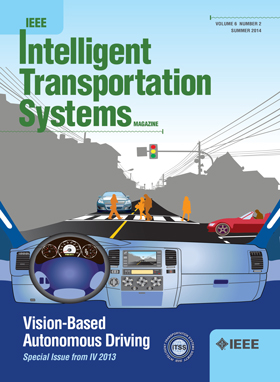Heterogeneous Pedestrian Simulation in Commercial Complexes: When Attractive Potential Meets Social Force
IF 7.9
1区 工程技术
Q1 ENGINEERING, CIVIL
IEEE Transactions on Intelligent Transportation Systems
Pub Date : 2025-02-28
DOI:10.1109/TITS.2025.3543613
引用次数: 0
Abstract
Commercial complex is a compositional scenario that involves pedestrians with different travel purposes such as commuting, shopping and business. Simulation of pedestrian behavior in a commercial complex is difficult due to the heterogeneity of pedestrians and different attractions from various kinds of shops. Inspired from the law of universal gravitation and the pedestrian dynamics theory, we propose an attractive potential based social force framework for pedestrian simulation in commercial complexes. Our framework consists of an attractive potential model and an attractive potential based social force model. The former model evaluates the attractive force of different types of shops towards heterogeneous pedestrians, by associating the attributes of pedestrians with the types of shops. The latter model effectively evaluates the travel direction of pedestrians by incorporating the attractive force with the social force model via a synthesis force criterion. We conduct the simulation experiment based on 600 groups of pedestrian tracking data collected in the China World Mall, Beijing, a typical commercial complex. The simulation results show that the model can effectively simulate not only the trajectory of real pedestrians, but also the behavior of entering shops. Our research significantly improves the authenticity of pedestrian simulation and provides support for travel behavior modeling of heterogeneous pedestrians in the commercial complex.商业综合体中的异质行人模拟:当吸引力与社会力量相遇
本文章由计算机程序翻译,如有差异,请以英文原文为准。
求助全文
约1分钟内获得全文
求助全文
来源期刊

IEEE Transactions on Intelligent Transportation Systems
工程技术-工程:电子与电气
CiteScore
14.80
自引率
12.90%
发文量
1872
审稿时长
7.5 months
期刊介绍:
The theoretical, experimental and operational aspects of electrical and electronics engineering and information technologies as applied to Intelligent Transportation Systems (ITS). Intelligent Transportation Systems are defined as those systems utilizing synergistic technologies and systems engineering concepts to develop and improve transportation systems of all kinds. The scope of this interdisciplinary activity includes the promotion, consolidation and coordination of ITS technical activities among IEEE entities, and providing a focus for cooperative activities, both internally and externally.
 求助内容:
求助内容: 应助结果提醒方式:
应助结果提醒方式:


